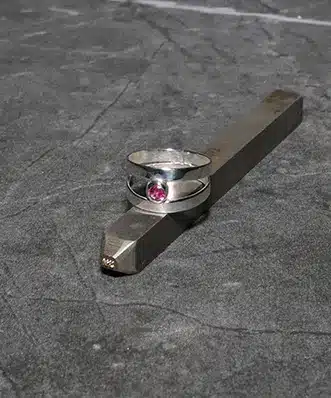I love working with silver. Creating silver jewelry – a timeless choice for adornment. Silver combines affordability and malleability, making it a staple in the jewelry industry for thousands of years. Sterling silver’s versatility and unique qualities keep it at the forefront of modern designs, favored by many artists and appreciated by consumers seeking stylish silver chains, silver rings, silver hoop earrings, and beaded bracelets.
Understanding Silver Quality – 3 Types of Silver in Jewelry
- Sterling Silver (92.5%): Predominantly used in jewelry, sterling silver consists of 92.5% pure silver and 7.5% other metals, typically copper, enhancing its durability and maintaining its lustrous appearance. This alloy is known for its bright and shiny finish but requires maintenance as it tarnishes over time. *I used .925 (for it’s durability) to make all my handmade pieces.
- Fine Silver (99.9%): Representing a purer form, fine silver contains 99.9% silver, making it softer and more prone to damage, which limits its use primarily to less handled jewelry pieces like earrings and necklaces.
- Silver Plated and Silver Filled: Silver-plated jewelry has only a thin layer of silver over a base metal, which may wear off, while silver-filled pieces contain a thicker layer of silver bonded to a base metal, offering slightly better durability but still less than sterling silver.
Identifying Quality Silver Jewelry
- Hallmarks and Stamps: Always check for hallmarks such as ‘925’, ‘sterling’, or ‘Ster’, which indicate the purity of the silver. These markings are a standard for identifying quality sterling silver.
- Physical Properties: High-quality silver should not attract a magnet, and real silver will turn a polishing cloth black, indicating its authenticity.
Considerations and Tests for Silver Quality
- Acid Test: A drop of nitric acid can help verify the silver’s purity; a creamy white reaction suggests high-quality silver, while a green reaction indicates silver plating.
- Weight and Sound: Genuine silver jewelry is heavier and produces a distinct, rich sound when struck, compared to lower quality metals.
- Price and Appearance: While higher quality silver is generally more expensive, price should not be the sole indicator of quality. Observing the craftsmanship and overall finish can also provide insights into the material’s quality.
Factors to Consider Before Buying
Design and Quality
When selecting silver jewelry, it’s crucial to choose a design that reflects your personal style and is crafted to last. Look for pieces without visible defects like scratches or dents, as high-quality silver should be durable and resistant to such damage. The design should not only appeal to your aesthetic but also ensure longevity.
Pricing and Seller Reliability
Silver jewelry prices fluctuate based on market trends, with current prices being significantly lower than they were a decade ago, making it an opportune time for investment. Choosing a reputable seller is equally important, especially online. Check for good reviews and confirm if they guarantee the authenticity of their products.
Environmental and Stylistic Considerations
Consider eco-friendly options like recycled silver, which supports environmental sustainability Also, think about how the jewelry matches with your wardrobe and occasions. For everyday wear, opt for simpler, versatile designs, while more elaborate pieces might be reserved for formal events. Mixing silver with other metals like gold can create a striking look, offering more variety in accessorizing.
Choosing Silver Jewelry with Gemstones
Silver jewelry adorned with gemstones combines the lustrous appeal of silver with the vibrant colors of various stones, creating pieces that are both timeless and versatile. When selecting gemstone silver jewelry, it’s essential to consider both the design and the quality of craftsmanship. Superior craftsmanship not only ensures the durability and longevity of the jewelry but also enhances the natural beauty of the gemstones used.
Understanding Gemstone Quality
Gemstone quality is pivotal in choosing the right piece of jewelry. It’s important to understand the hardness of the gemstones, as this affects their durability and suitability for different types of jewelry. Gems like diamonds, sapphires, and rubies, with a hardness of 8 or higher on the Mohs scale, are durable and ideal for everyday wear. In contrast, softer gems such as emeralds, aquamarines, and tourmalines are more vulnerable and are better suited for less frequently worn items like earrings and pendants.
Types of Jewelry Settings
The setting of a gemstone in silver jewelry significantly impacts both its aesthetics and functionality. Here are some common types of settings:
- Bezel Setting: This involves a metal rim that holds the gemstone by encircling its outer edge. It is versatile and secure, requiring minimal maintenance, although it may make the gemstone appear slightly darker.
- Prong Setting: Typically involves four to eight thin metal tines that hold the gemstone in place. This setting allows maximum light exposure, enhancing the stone’s color, but it leaves parts of the gemstone more exposed and potentially vulnerable.
- Channel Setting: Gemstones are set closely together between vertical metal walls, which protect the stones and create a smooth, ribbon-like appearance. This setting is suited for stones cut in round, square, or baguette shapes.
- Pavé Setting: Small stones are set very close to each other, giving the appearance of a continuous surface of gems. This setting is often used for accent stones and creates the illusion of a larger singular gemstone.
Selecting the right setting involves balancing the aesthetic appeal with the practical aspects of jewelry care and wearability.
Caring for Your Silver Jewelry
Regular Cleaning and Storage
- Regular Cleaning: To maintain the natural luster of sterling silver, regular cleaning with silver polishing cloths or silver polish cream is essential. For a deeper clean, a mixture of baking soda and water can be used.
- Dry Storage: Store silver in individual, air-tight bags with anti-tarnish properties to prevent exposure to tarnishing elements like humidity and air. Ensure each piece of jewelry is unclasped and unhooked to avoid scratches.
- Avoid Chemicals: Keep your silver jewelry away from harsh chemicals found in household cleaners, perfumes, and cosmetics. Also, remove jewelry during activities that may expose it to chemicals, such as swimming or cleaning.
Preventative Measures for Tarnishing
- Frequent Wear: Wearing silver jewelry often can help maintain its shine as the skin’s natural oils aid in keeping it polished.
- Proper Handling: Always put jewelry on last to minimize contact with lotions and makeup, and take it off during activities that could expose it to harsh substances.
- Sunlight and Heat Exposure: Limit the exposure of your silver jewelry to direct sunlight and extreme temperatures to prevent oxidation.
Professional Care and DIY Solutions
- Annual Professional Cleaning: It is advisable to schedule an annual professional cleaning to ensure thorough maintenance and care of your silver jewelry.
- DIY Cleaning Solutions: For home-based care, gentle soap and water are recommended for routine cleaning. For more severe tarnish, consider using a mixture of white vinegar and baking soda, allowing the jewelry to soak for two to three hours before polishing with a specific cloth for sterling silver.
Summing it All Up
Through this comprehensive guide, I’ve outlined the nuanced landscape of silver jewelry, delving into the significance of sterling silver’s purity, the distinguishing marks of quality craftsmanship, and the enchanting world of gemstone-adorned silver pieces. The insights provided aim to empower you with the knowledge to choose silver jewelry that not only enhances your personal style but also stands the test of time, balancing aesthetic appeal with durability. Furthermore, this guide underscores the importance of adopting responsible practices in the maintenance and care of silver jewelry, ensuring that these treasures retain their sparkle and significance for years to come.
In the quest to make informed decisions about silver jewelry selection, it becomes clear that understanding the intricacies of silver quality, the artistry of design, and the practicalities of jewelry care are paramount. As you reflect on this journey of discovery, remember the joy and beauty that well-chosen handmade silver jewelry can bring to everyday life. Take a moment to share this guide with those who appreciate the timeless beauty of silver jewelry, furthering the appreciation of this exquisite art form.


